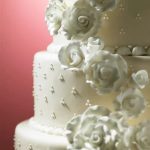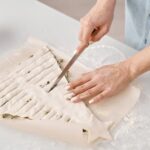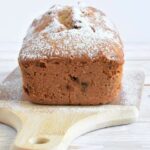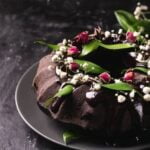Have you ever wondered how to decorate a frozen cake and make it look visually stunning? Decorating a cake is not only about making it visually appealing but also about adding a personal touch to any celebration. A beautifully decorated cake can elevate the overall mood of an event and leave a lasting impression on your guests.
When it comes to frozen cakes, the challenge lies in decorating them without compromising their texture or structure. Unlike room temperature cakes, frozen cakes require specific preparation and techniques to achieve the desired decorative outcome. However, with the right tools, materials, and know-how, decorating a frozen cake can be an enjoyable and rewarding experience.
In this article, we will explore the art of decorating a frozen cake, from understanding the importance of cake decoration to mastering various techniques and troubleshooting common mishaps. Whether you are a beginner or an experienced baker looking for inspiration, we have got you covered with tips and tricks for creating stunning frozen cake designs that will impress at any occasion. So let’s dive into the world of cake decoration and unleash our creativity on frozen canvases.
Tools and Materials Needed
There are several essential tools and materials needed to properly decorate a frozen cake. These include piping bags, tips, spatula, fondant, edible glitter, food color gels, and other decorative items like edible flowers or pearls. Piping bags are used to apply frosting or create intricate designs on the cake, while tips come in various shapes and sizes to achieve different decorating effects.
A spatula is necessary for spreading frosting and achieving a smooth finish on the cake’s surface. Fondant is a versatile material that can be rolled out and cut into different shapes for decorative purposes.
When decorating a frozen cake, it’s important to make sure that all the tools and materials are of good quality to achieve professional-looking results. Low-quality piping bags or tips can make the decorating process more difficult and affect the overall outcome of the cake. It’s also recommended to have a turntable to easily rotate the cake while decorating, ensuring an even application of frosting or fondant.
In addition to the basic tools and materials mentioned above, it’s also beneficial to have a few extras on hand. These may include offset spatulas for precision work, parchment paper for creating stencils or templates, and a small brush for applying edible glue when attaching decorations. By having all these tools and materials ready before starting the decoration process, you can ensure a smoother workflow and better results in decorating your frozen cake.
| Tools and Materials | Description |
|---|---|
| Piping Bags | Used for applying frosting or creating designs on the cake |
| Tips | Come in various shapes/sizes for different effects |
| Spatula | Necessary for spreading frosting and achieving smooth finish |
| Fondant | Versatile material that can be rolled out/cut into shapes |
Preparing the Frozen Cake
When it comes to decorating a frozen cake, proper preparation is key to achieving a professional and visually appealing result. Thawing and crumb coating the cake are essential steps that lay the foundation for successful decoration. Here’s a step-by-step guide on how to properly prepare a frozen cake for decoration.
Thawing the Cake
The first step in preparing a frozen cake for decoration is allowing it to thaw properly. It’s important to plan ahead and give the cake enough time to thaw at room temperature. Depending on the size of the cake, this process can take several hours. It’s crucial to ensure that the cake is completely thawed before moving on to the next steps, as attempting to decorate a partially frozen cake can lead to uneven frosting and decorations.
Crumb Coating
Once the cake has thawed, it’s time to apply a crumb coat. A crumb coat is a thin layer of frosting that seals in any loose crumbs on the surface of the cake, providing a smooth base for additional decorations.
To apply a crumb coat, use an offset spatula to spread a thin layer of frosting over the entire surface of the cake. This initial layer will help capture any loose crumbs and prevent them from showing through in the final decorated cake.
Chilling the Crumb Coated Cake
After applying the crumb coat, it’s recommended to chill the cake in the refrigerator for about 15-20 minutes. This step allows the crumb coat to set and provides a firm base for adding additional layers of frosting or decorations. Once chilled, the cake is ready for further decorating techniques or additional layers of frosting.
By carefully following these steps of thawing and crumb coating, you’ll be well-prepared to move on to choosing decorations and implementing various decorating techniques for your beautifully adorned frozen cake.
Choosing the Right Decorations
When it comes to decorating a frozen cake, there are numerous options to consider in terms of decorations. Each decoration choice can greatly impact the overall look and feel of the cake, so it’s important to choose the right option for your desired outcome. Some popular choices for frozen cake decorations include buttercream, fondant, edible flowers, piping designs, and edible glitter.
Buttercream
Buttercream is a classic choice for decorating cakes and is known for its creamy texture and delicious taste. It can be used to create smooth finishes, textured designs, and intricate piping details. Buttercream also allows for vibrant coloring and is versatile in creating different decorative elements on a frozen cake.
Fondant
Fondant is a pliable icing that can be rolled out and draped over a cake to create a smooth, flawless finish. It is especially popular for themed or sculptural cakes as it allows for intricate details and unique shapes. Fondant can also be molded into 3D decorations such as flowers, figures, or geometric patterns.
Edible Flowers and Piping Designs
For a more natural and organic look, consider using edible flowers to decorate your frozen cake. Edible flowers not only add beauty but also bring a subtle flavor to the cake. On the other hand, piping designs can be used to create elaborate patterns or intricate details with precision using different types of piping tips.
Edible Glitter
Edible glitter is an excellent way to add sparkle and shine to your frozen cake without sacrificing on safety. It comes in various colors and shades, making it perfect for adding a touch of glamour to any design. Edible glitter can be dusted over the entire cake for an ethereal effect or used selectively on specific areas as accents.
Remember when choosing decorations for your frozen cake to consider the theme or occasion, as well as personal preferences of taste and style. Ultimately, the right decoration will elevate the overall look of your frozen cake and leave a lasting impression on those who get to enjoy it.
Decorating Techniques
Decorating a frozen cake requires creativity and the use of various decorating techniques to achieve a visually appealing and professional-looking end result. Whether you’re frosting a smooth cake, creating textured designs, using stencils, or applying edible images, mastering these techniques will take your frozen cake from ordinary to extraordinary.
When frosting a frozen cake, it’s essential to work quickly and efficiently to ensure that the frosting adheres to the surface without causing it to melt or become too soft. To achieve a smooth finish, consider using a bench scraper or offset spatula for even application. Start by applying a thin layer of frosting as a crumb coat before adding a thicker layer for the final finish.
Creating textured designs on a frozen cake allows for endless possibilities in terms of decoration. Consider using different piping tips to create unique patterns and textures with buttercream or royal icing. You can also experiment with fondant to mold intricate designs and shapes that add depth and visual interest to the cake.
Using stencils is another popular technique for adding decorative elements to a frozen cake. Whether you’re looking to incorporate delicate lace patterns, bold geometric shapes, or intricate floral designs, stencils provide an easy way to achieve precise details without the need for advanced artistic skills.
Applying edible images is a great way to personalize a frozen cake for special occasions. With advancements in technology, edible ink printers allow for high-resolution images and designs to be printed directly onto sheets of edible paper, which can then be applied to the surface of the cake with ease. This technique opens up endless possibilities for customization and personalization when decorating frozen cakes.
Incorporating these various decorating techniques into your repertoire will elevate your ability to decorate frozen cakes and unleash your creativity in creating visually stunning dessert masterpieces. Whether you’re aiming for a simple yet elegant look or an elaborate custom design, mastering these techniques will help you achieve impressive results that are sure to impress any audience.
Tips for Success
When it comes to decorating a frozen cake, there are several tips and tricks that can help achieve a professional-looking and beautifully decorated result. Here are some valuable tips for success:
- Keep the cake chilled: It’s important to keep the frozen cake cold during the decorating process. This will help the frosting and decorations adhere better to the surface and prevent the cake from melting or becoming too soft.
- Use a turntable: A turntable makes it easier to frost and decorate a cake evenly. By rotating the cake while applying frosting or decorations, you can ensure a smooth and consistent finish.
- Practice piping techniques: If you plan on using piping bags for decorative designs, take some time to practice different piping techniques on parchment paper before applying them to the actual cake. This will help you perfect your skills and create more precise designs.
In addition to these tips, it’s also essential to plan ahead and have all your tools and materials organized before beginning the decoration process. This includes making sure you have enough frosting, fondant, edible decorations, and any specific tools or equipment needed for your chosen decoration techniques.
By following these tips for success, you can elevate your frozen cake decorating skills and create stunning cakes that are not only visually appealing but also delicious. With practice and attention to detail, anyone can achieve professional-looking results when decorating a frozen cake.
Troubleshooting
Decorating a frozen cake can sometimes come with its challenges, but there are solutions to common mishaps that can help salvage the situation. One common issue is air bubbles in the frosting, which can create an uneven look on the cake. To fix this problem, simply use a toothpick to gently poke the air bubbles and then smooth out the frosting with a spatula.
Another frequent problem when decorating a frozen cake is the frosting not sticking properly due to condensation. If you encounter this issue, try blotting the cake gently with a paper towel to absorb excess moisture before applying the frosting. Additionally, allowing the cake to thaw slightly longer can also help reduce condensation.
When working with fondant decorations, cracking or tearing can occur if it becomes too dry. To prevent this, be sure to knead the fondant well before rolling it out and work quickly to apply it onto the cake. If cracks or tears do appear, lightly brush some water onto the affected areas and press them together gently to mend.
Overall, troubleshooting decorating mishaps requires patience and attention to detail. It’s important not to panic if something goes wrong – often, there is a simple solution that can save your beautifully decorated frozen cake. With practice and experience, you’ll become more adept at handling and fixing these common issues as you continue refining your cake decorating skills.
| Common Decorating Mishap | Solution |
|---|---|
| Air bubbles in frosting | Use a toothpick to gently poke air bubbles and then smooth out frosting with a spatula |
| Frosting not sticking due to condensation | Blot cake gently with paper towel before applying frosting and allow for longer thawing time |
| Fondant cracking or tearing | Knead fondant well before rolling it out, work quickly when applying it onto the cake; if cracks or tears occur, lightly brush water onto affected areas and press together gently |
Final Touches and Presentation
In conclusion, decorating a frozen cake can be a fun and rewarding experience, and with the right tools, materials, and techniques, anyone can create a stunning dessert centerpiece. The final touches and presentation play a crucial role in enhancing the overall look of the decorated frozen cake. Adding borders using piping or fondant can help frame the design and give the cake a polished finish.
Additionally, using cake stands of varying heights can create visual interest and elevate the presentation of the cake. It’s also important to incorporate matching decor such as themed toppers, edible flowers, or colored sprinkles to tie everything together for a cohesive look.
Remember that practice makes perfect when it comes to cake decorating. Don’t be afraid to experiment with different techniques and decoration options to find what works best for your personal style and taste. Whether it’s creating textured designs with buttercream or using stencils for precision, each decorated frozen cake is an opportunity to improve your skills and unleash your creativity.
Lastly, don’t forget that the most important part of decorating a frozen cake is to have fun. Enjoy the process of transforming a simple dessert into a work of art that will delight both the eyes and the taste buds of those who will enjoy it. With patience, creativity, and attention to detail, anyone can master the art of decorating a frozen cake like a professional pastry chef.
Frequently Asked Questions
How Long to Thaw Frozen Cake Before Frosting?
Thawing a frozen cake before frosting typically takes about 2-3 hours at room temperature. It’s important to allow the cake to thaw slowly to avoid any moisture loss or texture changes. Once the cake is completely thawed, it can be frosted and decorated as desired.
Can You Decorate a Cold Cake?
Yes, you can decorate a cold cake, but it’s important to keep in mind that some decorations may not adhere as well to a cold surface. To ensure the decorations stay in place, it’s best to let the cake come to room temperature before decorating.
However, if time is a constraint, using buttercream frosting or slightly warming the decorations can help them stick to a cold cake.
How Do You Refresh a Frozen Cake?
Refreshing a frozen cake involves allowing it to come to room temperature, then gently brushing off any frost with a pastry brush. Once the frost has been removed, the cake can be re-frosted or decorated as desired.
It’s important for the cake to fully thaw and for any excess moisture from condensation to evaporate before adding fresh frosting or decorations.

Welcome to my blog about home and family. This blog is a place where I will share my thoughts, ideas, and experiences related to these important topics. I am a stay-at-home mom with two young children. I hope you enjoy reading it! and may find some helpful tips and ideas that will make your home and family life even better!





